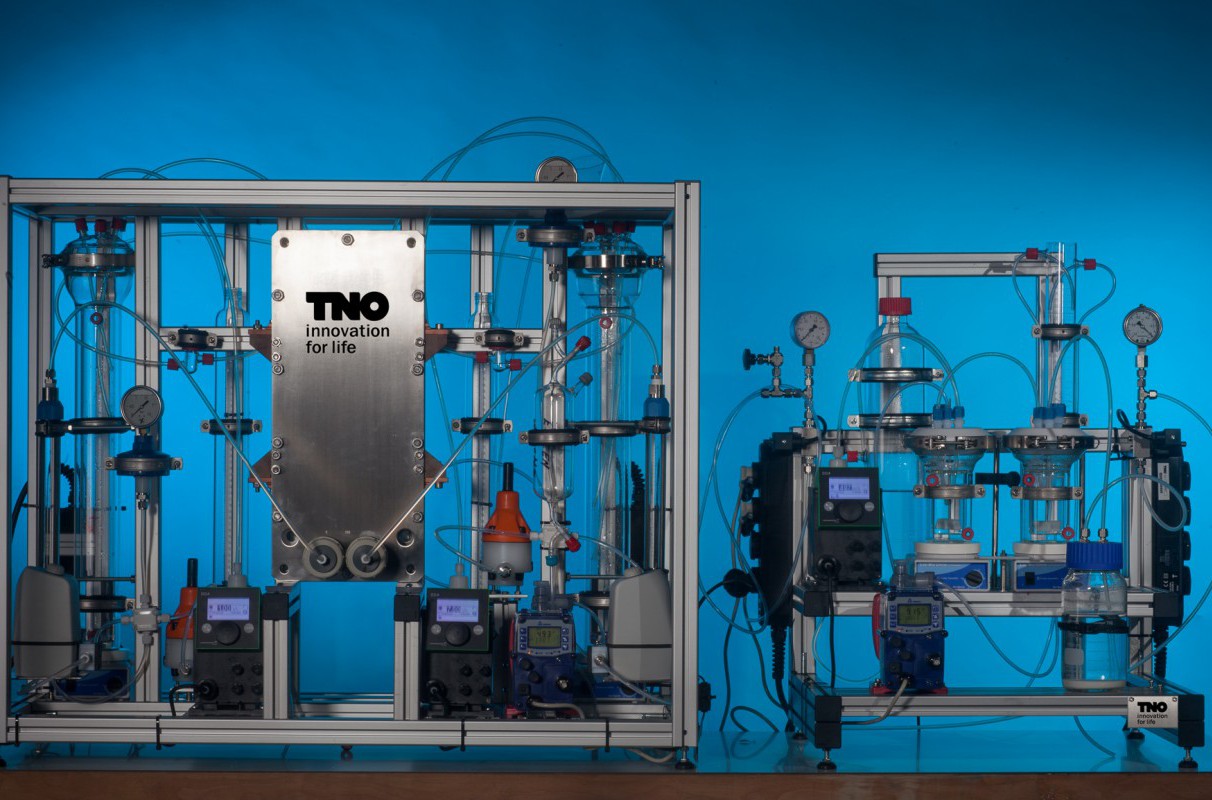

VoltaChem demonstrates continuous electrochemical FDCA production
02-05-2017
 Electrochemical oxidation towards high-value chemical products is one of the most interesting and promising applications of electrosynthesis on short term. Researchers from Shared Innovation Program VoltaChem have recently demonstrated a full continuous process for the conversion of biobased Hydroxymethylfurfural (HMF) to FDCA, a key intermediate for bioplastics. With the results in hand, the next step can be made towards optimization and pilot scale production.
Electrochemical oxidation towards high-value chemical products is one of the most interesting and promising applications of electrosynthesis on short term. Researchers from Shared Innovation Program VoltaChem have recently demonstrated a full continuous process for the conversion of biobased Hydroxymethylfurfural (HMF) to FDCA, a key intermediate for bioplastics. With the results in hand, the next step can be made towards optimization and pilot scale production.
As discussed earlier in the VoltaChem whitepaper 'Empowering the chemical industry - opportunities for electrification', direct electrochemical conversion of feedstock to chemicals is one of the primary routes for electrification of the chemical industry. Although commodity scale implementation of this technology cannot be expected within the coming years, there are already positive business cases to be expected on the short term in the production of high value chemicals, mainly due to the high selectivity and scalability of electrosynthesis. Therefore, VoltaChem co-initiator TNO has focused a large part of its research within VoltaChem on selective oxidations using electrochemical technology.
Electrochemical conversion of HMF to FDCA
As a showcase of high-value production, the selective oxidation of biobased 5-hydroxymethylfurfural (HMF) to furandicarboxylic acid (FDCA) was selected in 2015, where the latter is an upcoming building block for renewable plastics and this a high value chemical compound. Martijn de Graaff, business development manager for VoltaChem, explains: “Especially in biobased plastic applications, electrosynthesis has its added value due to the need for high selectivity. The feedstock is generally contaminated and the product has to be very pure for polymerization. Therefore, the interest in using new technology for decreasing the overall production costs of specifically FDCA has been increasing over the years. Furthermore, the market for FDCA is steadily growing due to the demand for more sustainable products. This made FDCA an ideal candidate to be taken as showcase.”
From lab to continuous production
In the last 2 years, the electrosynthesis research on FDCA has been progressing from proof-of-principle to proof-of-concept. Roman Latsuzbaia, scientist electrochemistry at VoltaChem/TNO, explains: “At the start of the project we investigated mechanisms of conversion of HMF to FDCA and optimized the conversion and product separation conditions towards industrially relevant conditions.” This led to optimized conversion conditions and allowed 100 % conversion of HMF to FDCA with 89% yield and 80 % current efficiency where product concentrations of 5-10 wt% were achieved.
Based on these laboratory results, a larger scale installation was designed and built for continuous production of FDCA, containing both electrochemical reactor and downstream processing units. In this installation, a continuous production of FDCA was achieved with a product concentration of 5 wt%. “This is a big step towards industrial electrochemical production of FDCA and we are proud to be the first to have done this worldwide!” As a result, a multilateral collaborative project has been initiated early 2017 together with public and private partners to further investigate and optimize the electrochemical production of FDCA with alternative improved reaction conditions and to develop the technology to commercial scale. Roman concludes: “We really look forward to bringing this technology into operations and contribute to the cost-competitive production of biobased plastics.“
Other applications
The electrochemical bench scale system that has been developed for FDCA production is not only applicable for that specific compound. The installation is generic and can be utilized for testing full electrochemical production of other chemical compounds as step prior to the design of a pilot scale electrochemical plant. The installation contains a reactor with modular electrodes, which means that the electrodes can be replaced depending on the requirements for any electrochemical reaction. Additionally, the reactor allows multiple cell compartments to test various stack configurations. Currently, TNO is investigating the production of other bio-based chemicals in this bench scale continuous setup, in the framework of the VoltaChem program.
More information
Any company that is interested to find out more about electrosynthesis is welcome to discuss the technical and business opportunities for their specific chemical conversion. We are more than happy to help with our know-how, network and R&D infrastructure.
Interested? Please contact Martijn de Graaff via +31 (0)6 22 26 08 71 or martijndegraaff@voltachem.com.
Please also check VoltaChem's call for participation in the field of electro-organic synthesis scouting projects.
Photo: electrolyzer set-up
Share this page: